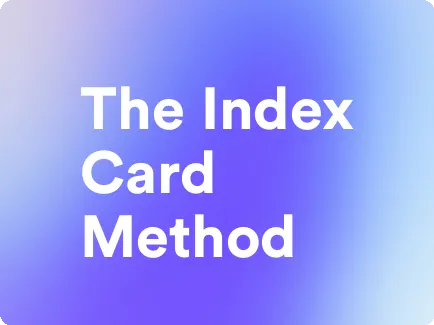The Index Card Method: A Simple Productivity Tool
This guide will walk you through the essential elements of using The Index Card Method - the productivity method to keep your team productive and engaged.
Try Lark for Free
In today's fast-paced world, staying organized and focused is key to achieving productivity. One age-old method that has stood the test of time is the Index Card Method. In this article, we will delve into what the Index Card Method is, its origin, who can benefit from it, its pros and cons, how to get started, actionable tips, do's and dont's, a step-by-step guide, and conclude with a set of FAQs to provide a comprehensive understanding of this effective productivity tool.
What is The Index Card Method?
The Index Card Method is a straightforward and versatile technique for organizing notes and thoughts using index cards as the primary tool. Each index card represents a single idea, task, or piece of information, allowing for easy rearrangement and reorganization. This method offers a tangible and visual way to manage and prioritize tasks, ideas, and projects, making it an effective tool for enhancing productivity and creativity.
What is the Origin of The Index Card Method?
The Index Card Method traces its roots back to the 1980s, with the pioneering work of renowned writer and professor, Robert Pirsig. Pirsig advocated for the use of index cards as a means of structuring and organizing writing projects, emphasizing the tactile and visual nature of the method. Over time, the method gained popularity among writers, students, professionals, and creatives as a simple yet powerful organizational tool.
Use Lark to unleash your team productivity.
Who is The Index Card Method For?
The Index Card Method is remarkably versatile and can benefit a wide range of individuals, including writers, students, professionals, creatives, and anyone seeking a practical system for organizing thoughts and tasks. It is particularly valuable for those who prefer a tactile and visual approach to information organization, as well as individuals who thrive on the flexibility of rearranging and categorizing ideas in a tangible format.
What are the Pros and Cons of The Index Card Method?
Pros
- Flexibility: Index cards can be easily rearranged, allowing for dynamic organization.
- Visual Organization: The method provides a visual overview of ideas and tasks.
- Tactile Engagement: Handling physical index cards can enhance engagement and memory retention.
- Portability: Index cards are portable, enabling productivity on the go.
Cons
- Physical Limitations: The method relies on physical index cards, which may be susceptible to loss or damage.
- Dependency on Space: Managing a large volume of index cards may require space and storage solutions.
- Limited Keyword Search: Unlike digital methods, searching for specific keywords on index cards may be challenging.
Learn more about Lark x Productivity
How to Get Started with The Index Card Method
Getting started with the Index Card Method is straightforward and requires minimal resources. Here are the essential steps to commence your journey with this productivity tool:
-
Gather Your Materials: Acquire a supply of index cards and writing utensils such as pens or markers.
-
Select a Central Theme or Project: Identify the overarching theme or project for which you intend to use the index cards.
-
Capture Ideas and Tasks: Begin jotting down individual ideas, tasks, or pieces of information on separate index cards.
-
Arrange and Prioritize: Once you have a collection of index cards, arrange them spatially and prioritize based on relevance or urgency.
Use Lark to unleash your team productivity.
Actionable Tips for The Index Card Method
Enhance your experience with the Index Card Method by implementing the following actionable tips:
- Color Code Categories: Utilize different colored index cards to represent distinct categories or priorities within your projects.
- Utilize Containers or Boxes: Store and organize your index cards in containers or boxes to prevent loss and facilitate easy access.
- Experiment with Layouts: Explore different spatial arrangements of index cards to find a visual organization that resonates with your workflow.
- Embrace Creativity: Use the tactile nature of index cards to sketch diagrams, mind maps, or visual representations of your ideas.
Do's and Dont's
Adhering to certain practices and avoiding common pitfalls can maximize the effectiveness of the Index Card Method. The following table illustrates the key do's and dont's:
| Do's | Dont's |
|---|---|
| Use a consistent and legible writing style | Overcrowd individual index cards with excessive content |
| Prioritize clarity and brevity: Ensure that each index card conveys a clear and concise idea or task | Rely solely on the Index Card Method without supplementing it with digital or backup systems |
| Regularly review and reassess the organization of index cards | Leave index cards in disorganized and scattered arrangements |
Conclusion
The Index Card Method stands as a testament to the enduring effectiveness of simple and tactile organizational tools. With its rich history, versatile applications, and tangible benefits, it continues to serve as a valuable resource for individuals across various domains. By embracing the tactile and visual nature of index cards, users can unlock new dimensions of creativity, organization, and productivity.
Use Lark to unleash your team productivity.
